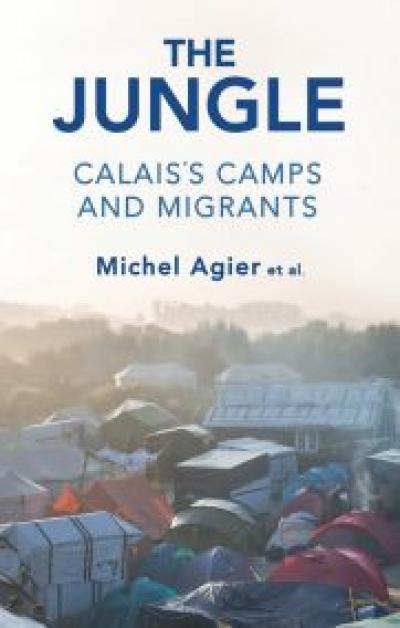Guest post by Antonella Patteri. Antonella is a PhD researcher in Politics at Birkbeck College, University of London. Her research focuses on the bio-political borders of the European Union, the relation between the politics of care and control, security and migration. She is on Twitter @AlmaPataramon.
Review of The Jungle: Calais’s Camps and Migrants by Michel Agier, Yasmine Bouagga, Madaleine Trépanier, and David Fernbach (Polity Press 2018).

These negotiations, and a detailed examination of a longer history of the border through its many encampments, are the subject of The Jungle: Calais’s Camps and Migrants. Written by Michel Agier and a team of multidisciplinary researchers, this book addresses the making of migration by considering the many processes of bordering in Calais. By retracing over twenty years of migration policies and migration movements in the area of Calais, the authors reconstruct this history with the help of research documents and interviews with the members of volunteer organizations. These methods prove to be particularly valuable in discussing the causes, effects, and life and death politics of the Calais Jungle as it existed from April 2015 to October 2016. This extended case study is at the core of The Jungle, where the authors adopt a ‘forensic anthropological’ approach to grasp the events that led to the formation of this camp and its local and global impact.
By offering what the authors call a descriptive, reflective and critical analysis, and an “archive of the present”, the book comprises five rich chapters that address chronologically the pre and post jungle experience. In the first chapter of The Jungle the authors ground the history of the Calais region in a series of events that took place from 1986 to 2016. Starting from how the policy of UK border control externalization played out in Northern France, this chapter considers the opening of the Channel tunnel in 1994; the growth of encampments and squats in the areas surrounding the town and the port of Calais; the so-called Sangatte moment between 1999-2000; the signing of the Touquet Treaty between the UK and France in 2003; the post-Sangatte management of migrants and the many policies of removal and eviction adopted by the Calais municipality. The reconstruction of this history helps us to situate Calais within a broader framework that accounts for current affairs.
In chapters two and three, the authors consider the formation and development of the Calais camp in 2015 and its partial destruction in October 2016. These two chapters look at the jungle from two different perspectives. While chapter two focuses on the ways in which the camp was inhabited through the informal architecture that reshaped the shantytown as a town, chapter three provides a sociology of the jungle by looking in detail into everyday life in this precarious space. Particularly interesting in this chapter is the authors’ discussion about the triangular relationship that unfolded between migrants, public authorities and voluntary organizations on the ground. Social divisions, relations of solidarity, economic life and modalities of resistance are read through the eyes of community building so as to recognise how the need for civil life was felt.
The Jungle also captures well the negative impact of state intervention in the making of this camp. While this aspect is discussed throughout the book, chapters four and five provide deeper insight into the hostile environment of Calais. Here, the authors expose how the destruction of this ‘official’ camp intertwined with hostile municipal decrees and violence carried out by the police against migrants. These aspects need to be taken into account if we want to understand what the authors call the rise of a ‘cosmopolitan crossroads of solidarities’. Such decrees and violence, culminating in the dismantling of the Jungle, also gave rise to mobilizations of citizens who organised with local NGOs and other aid networks. These mobilizations and the formation of these networks are presented as a counter-image to the spectacularised events that led to the destruction of the jungle in October 2016. These events are detailed in chapter five of the book, with important reflections about what is happening in Calais now that ‘the biggest shantytown in Europe’ has been dismantled but some of its population still exists as remnants of the EU’s violent policies.
The Jungle: Calais’s Camps and Migrants provides an important contribution to the field of border studies by historically considering these camps as a function of European borders more broadly. This collaborative study brings together multidisciplinary fieldwork connecting the regional environment of Calais with that of European policies, practices and discourses about borders and migration. The history of the present of Calais described in the book appeals to a wider audience, or as the authors put it, ‘to everybody wishing to address the situation’. Overall, this book is an essential addition to those interested in tracing and challenging processes of bordering in Northern France.
Overall, the book is extremely valuable and a necessary study to ground what has happened in Northern France. A strength of the book is that Agier and his co-authors do not only map sites of encampment but also raise the central question of how the politicization of migration has transformed the landscape of public order and justice in Calais. While the undesirables of the world continue to be policed in Northern France, the authors remind us of the value of the archipelago of solidarities that has emerged with it. Undoubtedly, this is the most inspiring theme of The Jungle, comforting us with the thought that if the camp is an extension of the border, these solidarities have the capacity to resist and expose the violence of border policing across Calais’ camps.
Any comments about this post? Get in touch with us! Send us an email, or post a comment here or on Facebook. You can also tweet us.
__________
How to cite this blog post (Harvard style)
Patteri, A. (2020). Book Review: The Jungle: Calais’s Camps and Migrants. Available at: https://www.law.ox.ac.uk/research-subject-groups/centre-criminology/centreborder-criminologies/blog/2020/11/book-review [date]








